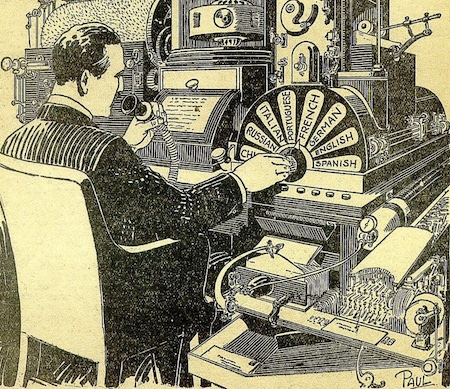Science Fiction
Dictionary
A B C D E F G H I J K L M N O P Q R S T U V W X Y Z
Latest By
Category:
Armor
Artificial
Intelligence
Biology
Clothing
Communication
Computers
Culture
Data Storage
Displays
Engineering
Entertainment
Food
Input Devices
Lifestyle
Living Space
Manufacturing
Material
Media
Medical
Miscellaneous
Robotics
Security
Space Tech
Spacecraft
Surveillance
Transportation
Travel
Vehicle
Virtual
Person
Warfare
Weapon
Work
"I myself feel that our country, for whose Constitution I fought in a just war, might as well have been invaded by Martians and body snatchers."
- Kurt Vonnegut, Jr.
| Vocal Typewriter | ||
| A device that accepts spoken dictation and produces printed copy. |
| My next improvement was to do away with any touch at all. I wanted a vocal typewriter — one that could be worked entirely by the voice. The mere articulation of each letter must be sufficient to close the proper circuit and print the letter." "Would that be possible?"
"Entirely so. My first model consisted of a series of gas jets 30 constructed that each flame flared up as soon as some particular letter was spoken. This flaring up closed an electric circuit and the letter was typed. In practice, however, such a machine was too delicate for general use, the great difficulty being, keeping the gae jets properly adjusted. In spite of differences of temperature. But I finally devised a machine that worked with a phonograph. When the letter was spoken the vibration of the diaphragm would turn on the proper current to strike the letter."
 (Vocal Typewriter from 'Dr. Hackensaw's Secrets Some Minor Inventions' by Clement Fezandie) "How about capital letters?" "In dictating, it is necessary to use the prefix 'cap' when you wish the next letter to he a capital. Thus, if you were dictating the name 'Dickens' you would have to say: 'Cap D-i-c-k-e-n-s' and the machine would write the word properly with the capital 'D.' "Flushed with my success I decided to go further and write whole syllables instead of letters. By using the phonograph there was no limit to the number of different keys I would use, hence I could have separate keys for thousands of syllables, although the typewriter itself needed but twenty-six letters." "How did you manage that?" "Each syllable key was so arranged that when depressed it switched on in turn all the letters which apelt the syllable. Thus when I spoke the syllable 'be,' the key tuned to work when this sound was uttered, received the electric current and, in descending it switched a second electric current on to the letters 'b' and 'e' in turn so that these two letters were written on the paper. A man could 'then dictate his letters to the machine just as he would to a stenographer..." My first machine had to be tuned to suit the voice of the dictator, but experience soon taught me to leave enough play so that the machine would answer to any voice. Try it yourself, and see how it works. Don't shout, just speak quietly into the mouthpiece just as you would at a telephone." Pep accordingly took up the mouthpiece and spoke a few sentences, with some coaching from the doctor as to the proper pronunciation, and was delighted to see that the machine typewrote from her dictation without a single error. |
| Technovelgy from Dr. Hackensaw's Secrets Some Minor Inventions,
by Clement Fezandie. Published by Amazing Stories in 1926 Additional resources -
|
Compare to the telescribe from A Question of Salvage (1939) by Malcom Jameson, the speakwrite from 1984 (1948) by George Orwell and the electrosecretary from A Fall of Moondust (1961) by Arthur C. Clarke.
Comment/Join this discussion ( 0 ) | RSS/XML | Blog This |
Additional
resources:
More Ideas
and Technology from Dr. Hackensaw's Secrets Some Minor Inventions
More Ideas
and Technology by Clement Fezandie
Tech news articles related to Dr. Hackensaw's Secrets Some Minor Inventions
Tech news articles related to works by Clement Fezandie
| Swedes Get 'Chipped' With Vaccine Passports |
| Meetings To Be Recorded And Scored For Body Language |
| Would You Get 'Chipped'? Michigan May Ban Employers |
| Workplace Monitoring Hell, I Mean, Tool For Safe Distancing |
Want to Contribute an
Item?
It's easy:
Get the name of the item, a
quote, the book's name and the author's name, and Add
it here.
| <Previous | Next> |
|
|
|
Technovelgy (that's tech-novel-gee!) is devoted to the creative science inventions and ideas of sf authors. Look for the Invention Category that interests you, the Glossary, the Science Fiction Invention Timeline, or see what's New.
|
Science Fiction
Timeline
1600-1899
1900-1939
1940's 1950's
1960's 1970's
1980's 1990's
2000's 2010's
'Power could be compressed thus into an inch-square cube of what looked like blue-white ice'
'It's so light that you can set it up in five minutes by yourself...'
'Heavy penalties... were to be applied to any one found driving manually-controlled machines.'
'Buy a Little Dingbat... electropen, wrist watch, pocketphone, pocket radio, billfold ... all in one.'
'... an elastic, tinted material that had all the feel and appearance of human flesh and epidermis.'
'It is remarkable that the long leverages of their machines are in most cases actuated by a sort of sham musculature...'
